Visual
Diedrick Brackens: darling divined
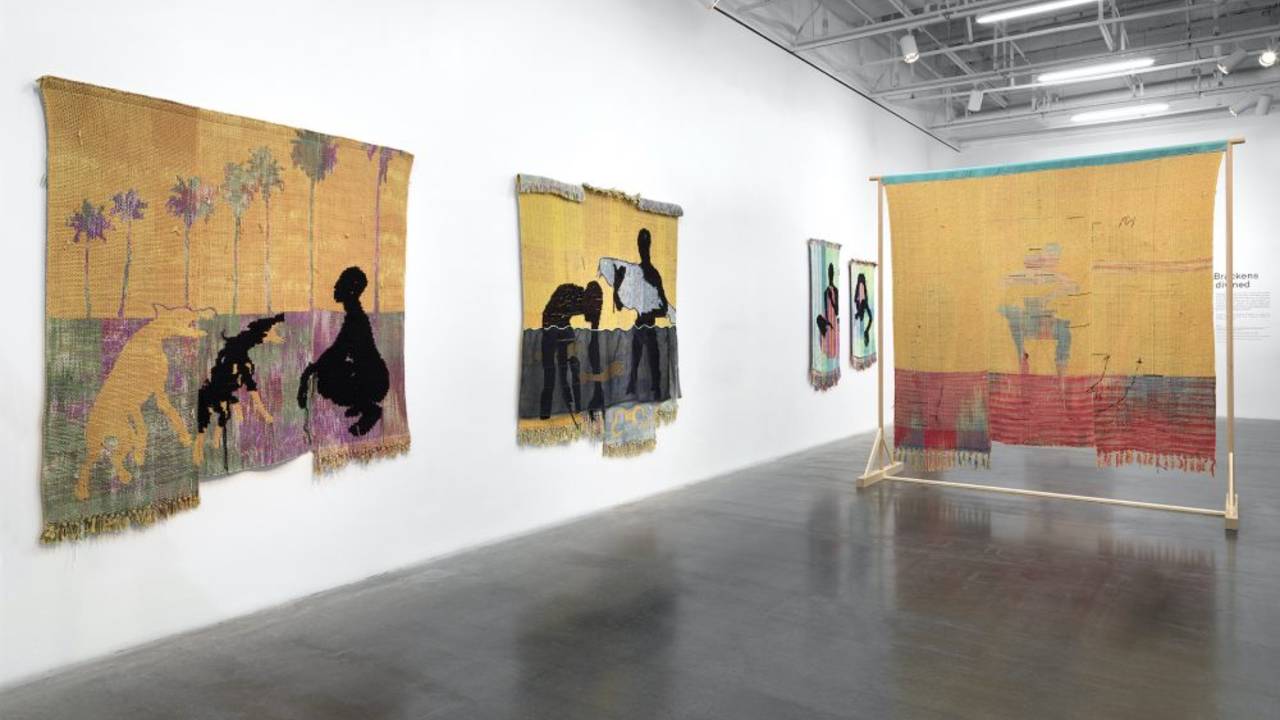
The Blanton Museum of Art at The University of Texas at Austin will present Diedrick Brackens: darling divined, the seventh Contemporary Project in the series from October 17, 2020 to May 16, 2021.
“It feels like a homecoming,” says Diedrick Brackens, of having an exhibition soon to be on view in the Lone Star State. From Mexia, Texas, and currently based in Los Angeles, Brackens honors Black and queer histories through textiles that imagine new futures through symbolic elements and evocative gestures.
This presentation of darling divined, originally organized by the New Museum, includes nine narrative weavings that draw inspiration from diverse sources ranging from European tapestries and quilts from the American south to popular culture, such as the film Moonlight. One of the key works, bitter attendance, drown jubilee (below), commemorates three Black teenagers who died in 1981 while in police custody in Mexia. As Brackens recently articulated: “I created the weaving as a way to tell the story and re-imagine its violent ending. To honor the lives lost, the boys are returned to the world transformed as catfish.”
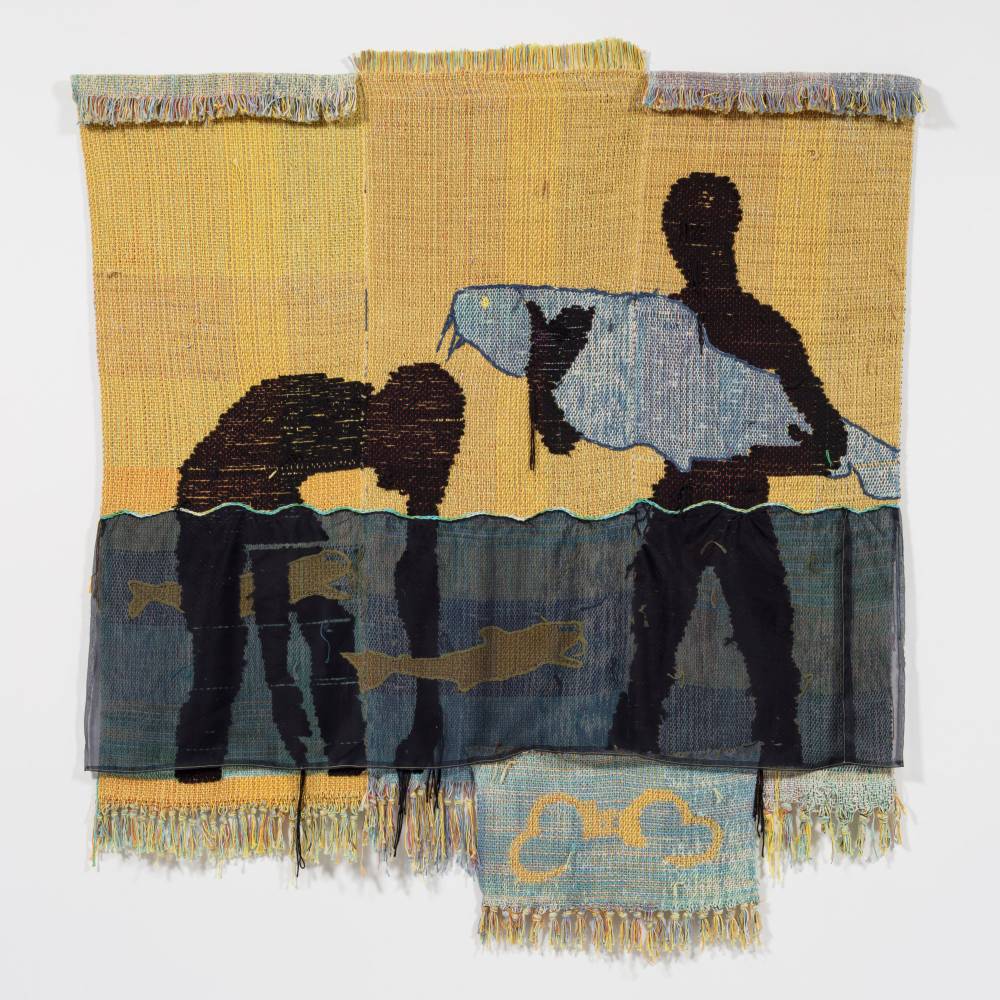
Diedrick Brackens: darling divined is organized by New Museum, New York. The exhibition is curated by Margot Norton, Curator, and Francesca Altamura, former Curatorial Assistant. The Blanton Museum of Art’s presentation is organized by Veronica Roberts, Curator of Modern and Contemporary Art.
Funding for this exhibition at the Blanton is provided in part by Fredericka and David Middleton, and the Loraine O’Gorman Gonzales Creative Craft Fund.

Visual
New Latino Art Galleries Now Open at the Blanton
Cara a cara / Face to Face: Portraits by Chicano Artists from the Gilberto Cárdenas and Dolores Garcia Collection is on view now through September 10, 2023.
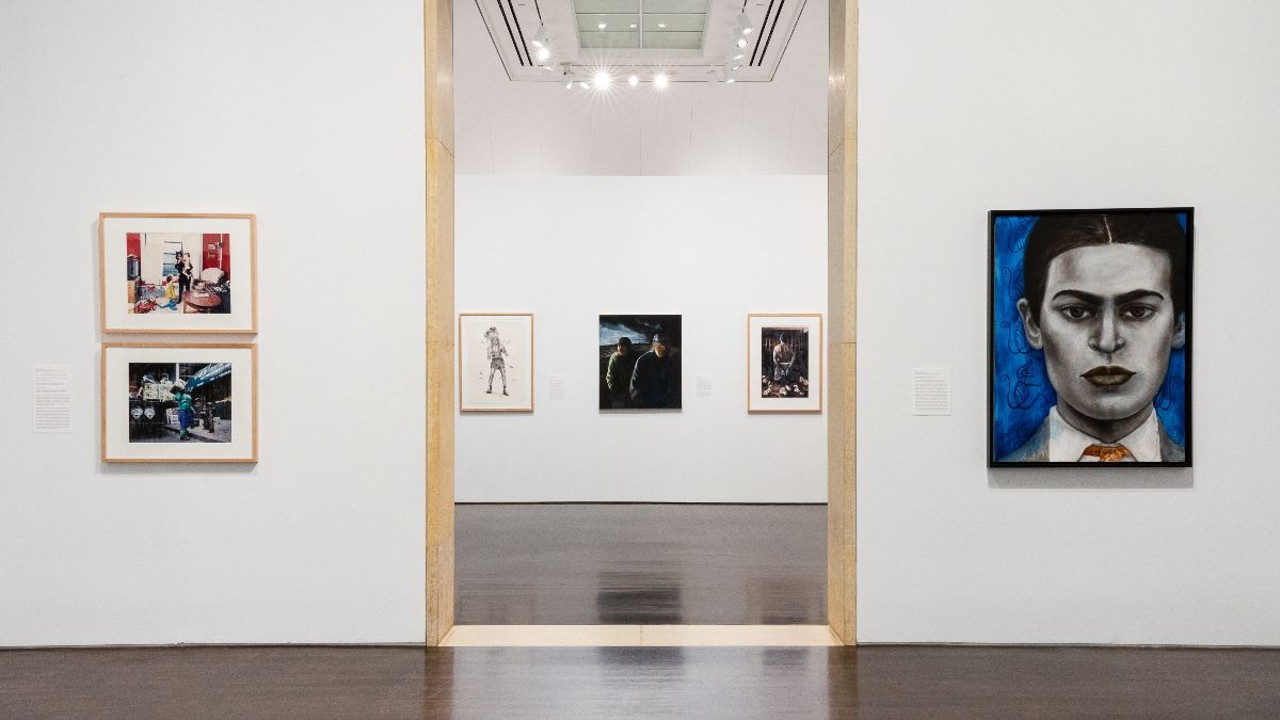
The Blanton Museum of Art at The University of Texas at Austin has opened two new collection galleries dedicated to Latino art as part of an institution-wide initiative to expand its focus on art by Latino artists. A major component of this initiative was the gift and purchase of over 5,000 artworks from the Gilberto Cárdenas and Dolores Garcia Collection, one of the largest private collections of Chicano and Latino art in the world.
The inaugural rotation of artworks in the galleries spotlights portraits from this important collection by Chicana and Chicano artists working in a range of media. Titled Cara a cara / Face to Face: Portraits by Chicano Artists from the Gilberto Cárdenas and Dolores Garcia Collection, it features artists who have chosen portraiture as a form of personal, cultural, or political affirmation. These works depict people from all walks of life, celebrating stories belonging to Mexican American communities. The featured artists also embrace the portrait as a platform to address issues of social justice, ranging from politically provocative images shaped by the Chicano movement for civil rights, to the use of humor and ambiguity in more recent examples. Among the artists included are Connie Arismendi, Claudio Dicochea, Gaspar Enríquez, Esperanza Gama, Carmen Lomas Garza, Yolanda López, Delilah Montoya, Malaquías Montoya, Dulce Pinzón, George Yepes, and Vincent Valdez.
The Blanton is in the final stages of hiring an Associate Curator of Latino Art who will program future rotations in the galleries, in addition to directing the project to catalogue, document, and digitize works from the Cárdenas/Garcia collection. This new curatorial position is funded by the Advancing Latinx Art in Museums initiative.
Visual
Blanton Museum of Art Presents First U.S. Retrospective of Oscar Muñoz

The Blanton Museum of Art at The University of Texas at Austin will present Oscar Muñoz: Invisibilia, the first retrospective of renowned Colombian artist Oscar Muñoz presented in the United States. Co-organized by the Blanton Museum of Art and Phoenix Art Museum, the retrospective premiered in Phoenix in September 2021 and will be on view at the Blanton from February 20 to June 5, 2022.
Invisibilia includes approximately 40 evocative artworks in diverse media that Muñoz has created over the last five decades. Disparate works are united by Muñoz’s consistent explorations of themes of memory, time, history, and knowledge. They range from his early charcoal drawings of the late 1970s to videos produced in the present day, and hybrid artworks in which Muñoz combines photographic processes with drawing, printmaking, installation, video, sculpture, and interactive elements. The exhibition will showcase works rarely seen outside of Colombia and will also debut new works created between 2019 and 2021.
“It is an honor to present the first retrospective of Oscar Muñoz’s work in the United States, which will help bring greater awareness to the remarkable work of a leading contemporary artist whose major U.S. debut is long overdue,” said Blanton director Simone Wicha. “We are delighted to partner with Phoenix Art Museum in organizing this timely exhibition. Oscar Muñoz: Invisibilia also represents the Blanton’s first exhibition dedicated solely to Colombian art, a cornerstone of the museum’s vast collection of 20th-century and contemporary Latin American art. Above all, I’m excited for our community to visit this unique, immersive exhibition. Muñoz uses varying media in such ingenious ways to explore ideas we can all relate to, provoking deeply moving experiences that stay with us long after encountering his work.”
Born in 1951 in Popayán, Colombia, and active in Cali, Muñoz is internationally renowned for riveting works that splice the media of film, video, photography, painting, drawing, and installation. His primary investigations are of such elusive yet universal themes as identity, social amnesia, memory, and the transience of life. Working in a country beset by the catastrophes of civil war, he employs ephemeral materials like light, water, fire, and dust to create portraits and experiential works that associate the precarity of the image with the fragility of life. As the foundation of his practice, Muñoz deconstructs photographic processes due to the medium’s inherent relationship with concepts of time, history, and objective truth, in addition to its great potential for being manipulated for other formal and conceptual concerns. Although he does not consider himself a photographer, Muñoz was awarded the 2018 Hasselblad Foundation International Award in Photography.
Curated by Vanessa Davidson, Blanton curator of Latin American art and former Shawn and Joe Lampe Curator of Latin American Art at Phoenix Art Museum, Invisibilia represents the first collaboration between the Blanton and Phoenix Art Museum. Davidson has worked closely with Muñoz since 2018 to create this retrospective that traces the evolution of the artist’s radical practice over five decades.
“The universality of Oscar Muñoz’s work lies in his exploration of far-reaching themes of identity, time, knowledge, and history in diverse media,” said Davidson. “As viewers experience the exhibition, I hope they consider the ways in which Muñoz uses the simplest means, such as water painted on sun-warmed cement, to illustrate the transience of the image as a metaphor for the transience of life. His artworks are often fleeting—yet they become indelible in our imaginations.”
“Acclaimed for his contributions to conceptual photography and use of innovative techniques and materials, Muñoz is one of the most significant contemporary artists—not only in his native country, but in Latin America at large,” noted Carter E. Foster, Blanton Deputy Director for Curatorial Affairs. “This important survey of his works testifies to Vanessa Davidson’s extensive research into Muñoz’s practice and commitment to expanding conversations around contemporary Latin American art. Four years in the making, Oscar Muñoz: Invisibilia has proven to be worth the wait.”
Invisibilia features works spanning the late 1970s through 2021, from early charcoal drawings in the Blanton’s collection to never-before-seen recent works that illuminate the artist’s increasing interest in literature and the configuration of text and image upon the page. Rather than presenting works chronologically, the presentation at the Blanton is organized into two nuclei that explore the intertwined themes at the heart of Muñoz’s experimental approach.
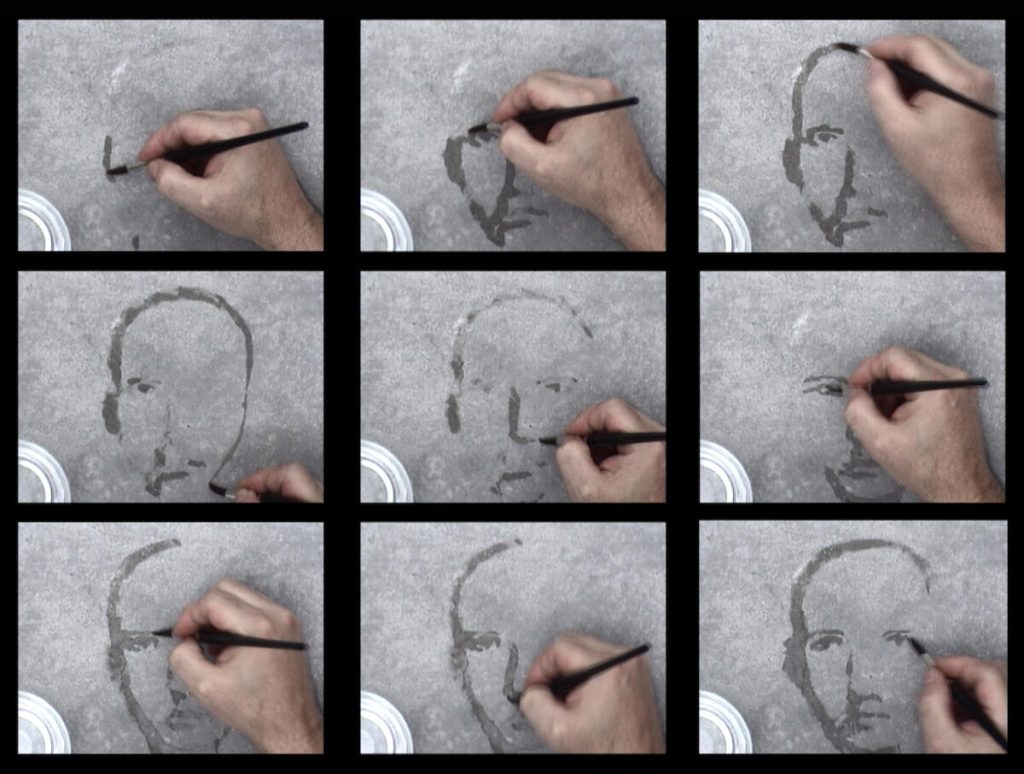
The first nucleus, Presence/Absence, features works that examine the nebulous gaps that remain where there was once a concrete form or physical being. The artworks in these galleries are defined by the simultaneous existence of traces of images and nothingness. The section begins with the video work Re/trato [Portrait/I Try Again] (2004), which depicts the artist attempting to paint a self-portrait with water on warm pavement; the portrait quickly vanishes once the liquid makes contact with the hot ground. Viewers watch as Muñoz tries in vain again and again to complete the image over the course of 28 uninterrupted minutes, much like the myth of Sisyphus futilely attempting to roll a boulder up a hill.
This nucleus likewise explores the tension between our ability to see and our blindness to experiences or histories that we might rather forget or that are physically erased, altered, or obscured from view. One key work, Paístiempo [Countrytime] (2007), features images and texts pyro-engraved on newsprint that dissolve and disintegrate as their pages are turned, mirroring the immediate obsolescence of periodicals the day after publication—as well as Colombians’ numbing overexposure to violence in the news. In the print work El Testigo, Sería Impresiones débiles [The Witness, Weak Impressions Series] (2011), Muñoz equally brings into question the objectivity of history and the camera lens. Here, the artist alters a historical photograph that depicts the relinquishing of arms by rebel groups in Columbia, changing the focus from the iconic handshake to the blind man in the background, who “witnesses” the truce.
In his earlier work Cortinas de baño [Shower Curtains] (1985-1986), Muñoz airbrushed ink in serigraphs on plastic shower curtains to create shadows of people in the bath, turning the viewer into a voyeur. This large-scale installation marks the artist’s first experiments with non-traditional media as well as his initial explorations of photographic processes.
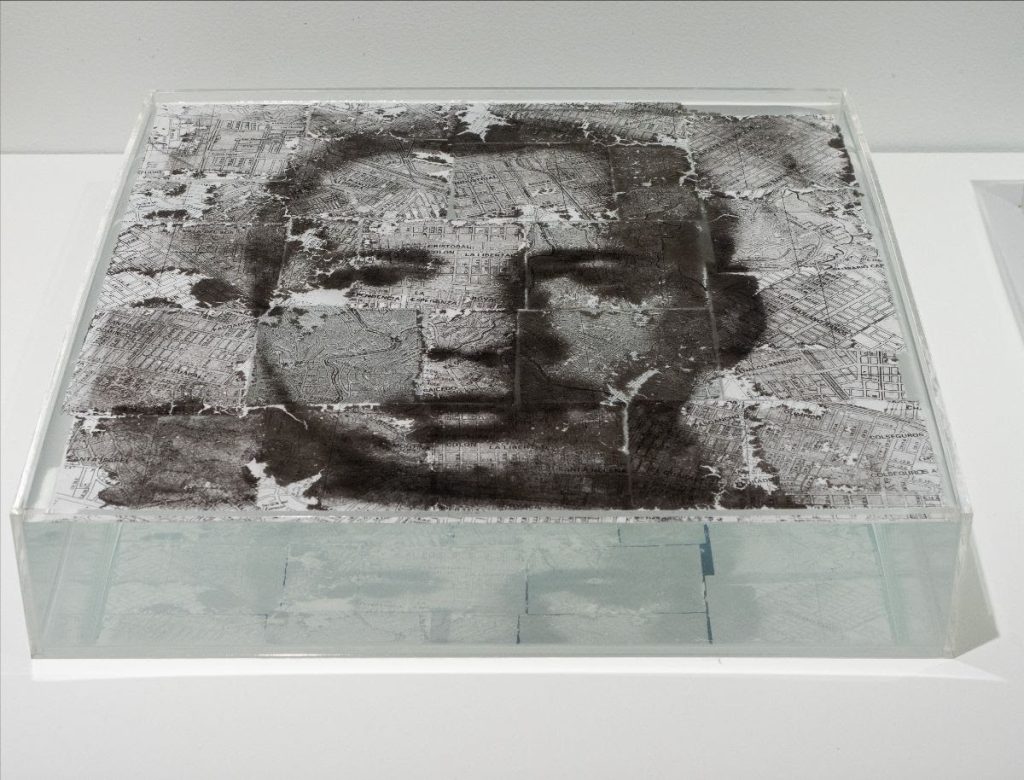
The second nucleus, Memory/Amnesia, highlights works revolving around the impossibility of permanence, especially in relation to memory and to the image itself. For Muñoz, both are impermanent and imperfect—subject to distortion, corrosion, or transfiguration over time. It opens with Narcisos en proceso [Narcissi in Progress] (1995-2011), a series of self-portraits created through the application of charcoal powder on the surface of water—a technique Muñoz developed that dematerializes the photographic image. As the water in the work’s acrylic trays evaporates over the course of the exhibition, the dust settles, leaving the image distorted upon the bottom. First created during the violent Colombian conflicts of the mid-1990s, Narcisos en proceso associates the precarious nature of the image with the ephemerality of life itself.
In other works, Muñoz touches upon the relentless violence in Colombia, but his approach is more philosophical than political. Created using sugar cubes stained with coffee—the foundation of Colombia’s export economy—his Pixeles [Pixels] (1999-2000) series re-creates images of the anonymous faces of those killed in the crossfire between Colombia’s military forces and insurgent rebels. Unless the viewer squints, these pixelated faces remain hazy and unclear, incongruously captured in sweet sugar.
The video works in this nucleus exemplify how Muñoz makes time and memory into malleable materials by revealing invisible intersections in the past and present, especially in Sedimentaciones [Sedimentations] (2011), Editor solitario [Solitary Editor] (2011), and El Coleccionista [The Collector] (2014-2016). In all three, a ghostly hand or figure moves photographs across surfaces, continuously rearranging or removing an almost endless collection of portraits drawn from sources as varied as Muñoz’s life, Colombian history, mythology, anonymous photographers’ archives, and art history. The narratives they engender change subtly when Muñoz places disparate images strategically in proximity to others. In our attempts to thread them together, we become the artist’s accomplice.
“Muñoz strives to ‘hacer memoria’—to ’make memory’— in his work,” concluded Davidson. “I hope visitors contemplate how the meanings of the photographs they take and keep to document their own lives change over time, and how they help to build memory and community. What do our selfies say about us, and how do they themselves ‘make memory’?”
Oscar Muñoz: Invisibilia will be accompanied by a bilingual catalogue in English and Spanish, constituting the first substantive monograph on the artist’s work in English. The exhibition catalogue will be the first to consider the impact of the artist’s entire five-decade career, featuring works from the 1970s through 2020 to underscore his contributions to the field of conceptual photography in Latin America and beyond. Designed by Tracey Shiffman Associates, published by Hirmer Publishers (New York and Berlin) in association with the University of Chicago, and edited by Vanessa Davidson, the book features two interviews with Oscar Muñoz as well as a text by the artist. Additional contributors include: Florencia Bazzano, Natalia Brizuela, Marta Gili, Mariángela Méndez, María Inés Rodríguez, Elena Shtromberg, Robert Storr, Joan Fontcuberta, and Alejandra Uslenghi.
Oscar Muñoz: Invisibilia is co-organized by the Blanton Museum of Art and Phoenix Art Museum.
Generous funding for this exhibition at the Blanton is provided by The Diane and Bruce Halle Foundation and the Carl & Marilynn Thoma Foundation, with additional support from Ellen and David Berman, Michael Chesser, and Sicardi | Ayers | Bacino.

